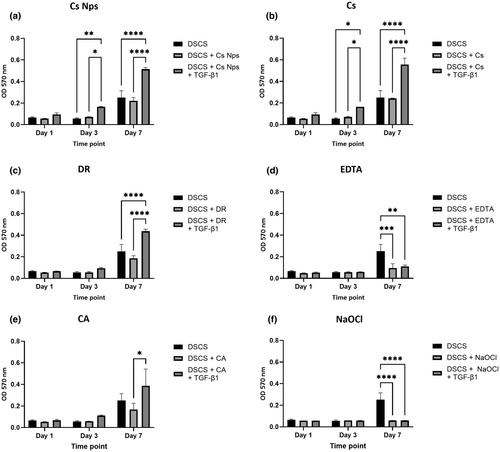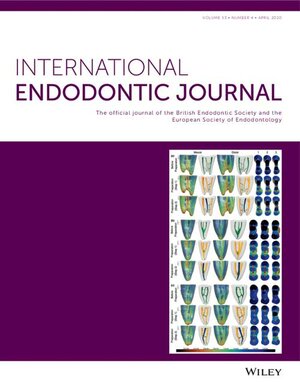Chitosan-based endodontic irrigation solutions and TGF-β1 treatment: Creating the most favourable environment for the survival and proliferation of stem cells of the apical papilla in vitro
Abstract
Background
The dental pulp's environment is essential for the regulation of mesenchymal stem cells' homeostasis and thus, it is of great importance to evaluate the materials used in regenerative procedures.
Aim
To assess in vitro (i) the effect of chitosan nanoparticles, 0.2% chitosan irrigation solution, Dual Rinse®, 17% EDTA, 10% citric acid and 2.5% NaOCl on DSCS viability; (ii) the effect of different concentrations of TGF-β1 on DCSC proliferation; and (iii) whether treatment with TGF-β1 following exposure to the different irrigation solutions could compensate for their negative effects.
Methodology
(i) DSCS were treated with three dilutions (1:10, 1:100 and 1:1000) of the six irrigation solutions prepared in DMEM for 10 and 60 min to assess the effect on viability. (ii) The effect of different concentrations (0, 1, 5 and 10 ng/mL) of TGF-β1 on DCSC proliferation was assessed at 1, 3 and 7 days. (iii) The proliferative effect of TGF-β1 following 10-min exposure to 1:10 dilution of each irrigation solution was also tested. We used MTT assay to assess viability and proliferation. We performed statistical analysis using Prism software.
Results
(i) The different endodontic irrigation solutions tested showed a significant effect on cell viability (p ≤ .0001). Significant interactions between the endodontic irrigation solutions and their dilutions were also found for all parameters (p ≤ .0001). Chitosan nanoparticles and 0.2% chitosan irrigation solution were the least cytotoxic to DSCS whilst 2.5% NaOCl was the most cytotoxic followed by 17% EDTA. (ii) TGF-β1 at concentrations of 1 and 5 ng/mL resulted in significantly higher proliferation compared to the control group. (iii) Exposure to 17% EDTA or 2.5% NaOCl for 10 min was sufficient to make DSCS cells refractory to the proliferative effects of TGF-β1. DSCS groups treated with TGF-β1 following exposure to chitosan nanoparticles, 0.2% chitosan irrigation solution, Dual Rinse® and 10% CA demonstrated significantly higher proliferation compared to non-TGF-β1-treated groups (p ≤ .0001, p ≤ .0001, p ≤ .0001 and p = .01 respectively).
Conclusions
The current study offers data that can be implemented to improve the outcome of regenerative endodontic procedures by using less toxic irrigation solutions and adding TGF-β1 to the treatment protocol.


 求助内容:
求助内容: 应助结果提醒方式:
应助结果提醒方式:


